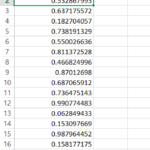How to transpose in Excel
Transposing data in Excel means switching the rows and columns in a table or range. Excel provides several ways to transpose data, depending on your specific needs. Here are three common methods to transpose data in Excel:
Method 1: Transpose Function (for a Static Transpose)
This method is suitable for transposing a fixed set of data. It doesn’t automatically update if the original data changes.
- Select the range of cells that you want to transpose.
- Copy the selected range (Ctrl+C).
- Right-click on the destination cell where you want to paste the transposed data.
- Under the Paste Special options, choose Transpose. You can find this option under Paste Special > Transpose when right-clicking, or you can go to the Home tab, click the drop-down arrow under Paste in the Clipboard group, and select Transpose.
The data will be transposed into the destination cells.
Method 2: TRANSPOSE Function (for Dynamic Transpose)
This method uses the TRANSPOSE function to dynamically transpose data. It updates automatically when the original data changes.
- Select the range where you want the transposed data to appear. Make sure the selected range has the same number of rows and columns as the original data.
- Enter the TRANSPOSE function as an array formula. To do this, type the function, then press Ctrl+Shift+Enter. For example, if your original data is in cells A1:B3, you’d enter the following formula in the selected range: =TRANSPOSE(A1:B3). Excel will add curly braces {} around the formula to indicate that it’s an array formula. Do not type these braces manually; they are added automatically when you use Ctrl+Shift+Enter.
- The original data will now be transposed into the selected range, and the transposed data will update automatically if you change the original data.
Method 3: Using Power Query (for Complex Transpositions)
Power Query is a powerful tool for data transformations, including transposing data. This method is suitable for more complex data transformations.
- Select the range containing the data you want to transpose.
- Go to the Data tab.
- Click Get Data or Get & Transform Data, depending on your Excel version.
- In the Power Query Editor window, select the columns you want to transpose.
- Right-click on the selected columns and choose Transpose.
- Click the Close & Load button to insert the transposed data into a new worksheet or location.
Power Query offers advanced data transformation capabilities and is particularly useful for handling large datasets or complex transpositions.
Choosing the Right Method
- Static Transpose: Use the Transpose function for a one-time transpose where the data does not need to update.
- Dynamic Transpose: Use the TRANSPOSE function for a dynamic, updating transpose.
- Complex Transpositions: Use Power Query for advanced data transformations and large datasets.



Leave a Reply